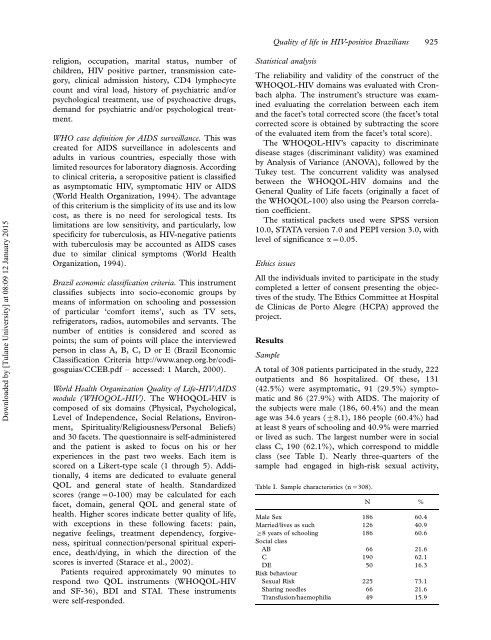WHOQOL-HIV (validação)
You also want an ePaper? Increase the reach of your titles
YUMPU automatically turns print PDFs into web optimized ePapers that Google loves.
Downloaded by [Tulane University] at 08:09 12 January 2015<br />
religion, occupation, marital status, number of<br />
children, <strong>HIV</strong> positive partner, transmission category,<br />
clinical admission history, CD4 lymphocyte<br />
count and viral load, history of psychiatric and/or<br />
psychological treatment, use of psychoactive drugs,<br />
demand for psychiatric and/or psychological treatment.<br />
WHO case definition for AIDS surveillance. This was<br />
created for AIDS surveillance in adolescents and<br />
adults in various countries, especially those with<br />
limited resources for laboratory diagnosis. According<br />
to clinical criteria, a seropositive patient is classified<br />
as asymptomatic <strong>HIV</strong>, symptomatic <strong>HIV</strong> or AIDS<br />
(World Health Organization, 1994). The advantage<br />
of this criterium is the simplicity of its use and its low<br />
cost, as there is no need for serological tests. Its<br />
limitations are low sensitivity, and particularly, low<br />
specificity for tuberculosis, as <strong>HIV</strong>-negative patients<br />
with tuberculosis may be accounted as AIDS cases<br />
due to similar clinical symptoms (World Health<br />
Organization, 1994).<br />
Brazil economic classification criteria. This instrument<br />
classifies subjects into socio-economic groups by<br />
means of information on schooling and possession<br />
of particular ‘comfort items’, such as TV sets,<br />
refrigerators, radios, automobiles and servants. The<br />
number of entities is considered and scored as<br />
points; the sum of points will place the interviewed<br />
person in class A, B, C, D or E (Brazil Economic<br />
Classification Criteria http://www.anep.org.br/codigosguias/CCEB.pdf<br />
accessed: 1 March, 2000).<br />
World Health Organization Quality of Life-<strong>HIV</strong>/AIDS<br />
module (<strong>WHOQOL</strong>-<strong>HIV</strong>). The <strong>WHOQOL</strong>-<strong>HIV</strong> is<br />
composed of six domains (Physical, Psychological,<br />
Level of Independence, Social Relations, Environment,<br />
Spirituality/Religiousness/Personal Beliefs)<br />
and 30 facets. The questionnaire is self-administered<br />
and the patient is asked to focus on his or her<br />
experiences in the past two weeks. Each item is<br />
scored on a Likert-type scale (1 through 5). Additionally,<br />
4 items are dedicated to evaluate general<br />
QOL and general state of health. Standardized<br />
scores (range0-100) may be calculated for each<br />
facet, domain, general QOL and general state of<br />
health. Higher scores indicate better quality of life,<br />
with exceptions in these following facets: pain,<br />
negative feelings, treatment dependency, forgiveness,<br />
spiritual connection/personal spiritual experience,<br />
death/dying, in which the direction of the<br />
scores is inverted (Starace et al., 2002).<br />
Patients required approximately 90 minutes to<br />
respond two QOL instruments (<strong>WHOQOL</strong>-<strong>HIV</strong><br />
and SF-36), BDI and STAI. These instruments<br />
were self-responded.<br />
Quality of life in <strong>HIV</strong>-positive Brazilians 925<br />
Statistical analysis<br />
The reliability and validity of the construct of the<br />
<strong>WHOQOL</strong>-<strong>HIV</strong> domains was evaluated with Cronbach<br />
alpha. The instrument’s structure was examined<br />
evaluating the correlation between each item<br />
and the facet’s total corrected score (the facet’s total<br />
corrected score is obtained by subtracting the score<br />
of the evaluated item from the facet’s total score).<br />
The <strong>WHOQOL</strong>-<strong>HIV</strong>’s capacity to discriminate<br />
disease stages (discriminant validity) was examined<br />
by Analysis of Variance (ANOVA), followed by the<br />
Tukey test. The concurrent validity was analysed<br />
between the <strong>WHOQOL</strong>-<strong>HIV</strong> domains and the<br />
General Quality of Life facets (originally a facet of<br />
the <strong>WHOQOL</strong>-100) also using the Pearson correlation<br />
coefficient.<br />
The statistical packets used were SPSS version<br />
10.0, STATA version 7.0 and PEPI version 3.0, with<br />
level of significance a0.05.<br />
Ethics issues<br />
All the individuals invited to participate in the study<br />
completed a letter of consent presenting the objectives<br />
of the study. The Ethics Committee at Hospital<br />
de Clínicas de Porto Alegre (HCPA) approved the<br />
project.<br />
Results<br />
Sample<br />
A total of 308 patients participated in the study, 222<br />
outpatients and 86 hospitalized. Of these, 131<br />
(42.5%) were asymptomatic, 91 (29.5%) symptomatic<br />
and 86 (27.9%) with AIDS. The majority of<br />
the subjects were male (186, 60.4%) and the mean<br />
age was 34.6 years (98.1), 186 people (60.4%) had<br />
at least 8 years of schooling and 40.9% were married<br />
or lived as such. The largest number were in social<br />
class C, 190 (62.1%), which correspond to middle<br />
class (see Table I). Nearly three-quarters of the<br />
sample had engaged in high-risk sexual activity,<br />
Table I. Sample characteristics (n308).<br />
N %<br />
Male Sex 186 60.4<br />
Married/lives as such 126 40.9<br />
]8 years of schooling 186 60.6<br />
Social class<br />
AB 66 21.6<br />
C 190 62.1<br />
DE 50 16.3<br />
Risk behaviour<br />
Sexual Risk 225 73.1<br />
Sharing needles 66 21.6<br />
Transfusion/haemophilia 49 15.9



